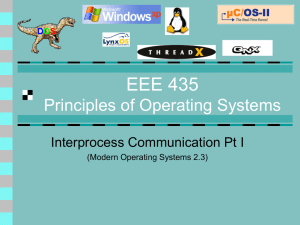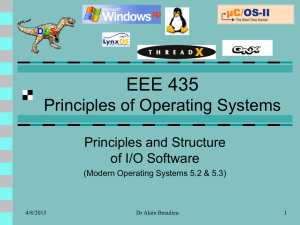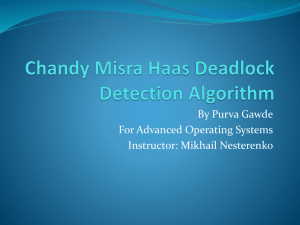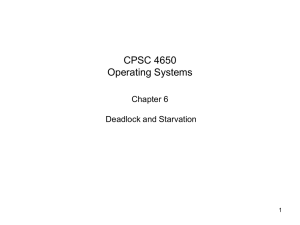EEE 435 Principles of Operating Systems
advertisement
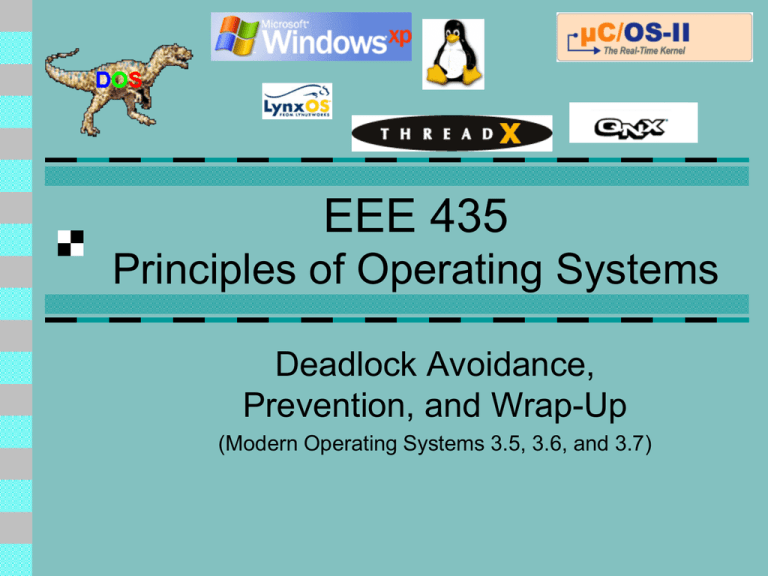
EEE 435 Principles of Operating Systems Deadlock Avoidance, Prevention, and Wrap-Up (Modern Operating Systems 3.5, 3.6, and 3.7) Quick Review How do we detect deadlocks with multiple instances of each resource? What are our four conditions for deadlock? 4/13/2015 Dr Alain Beaulieu 2 Outline Deadlock Avoidance Deadlock Prevention 4/13/2015 Dr Alain Beaulieu 3 Deadlock Avoidance So far we have seen two solutions to our deadlock problem: ignoring them and recovering from them Wouldn’t it be better if, through careful allocation of resources, we could prevent deadlocks from happening? This is known as Deadlock Avoidance 4/13/2015 Dr Alain Beaulieu 4 Deadlock Avoidance To avoid deadlocks, it is important not to proceed to a state that is unsafe A state is said to be safe if it is not deadlocked and there is some scheduling order in which every process can run to completion even if all of the processes were to immediately require their maximum number of resources to complete their work 4/13/2015 Dr Alain Beaulieu 5 Deadlock Avoidance If every process requests their maximum resources, is the starting state safe? Since every process could run to completion, the initial state was safe! 4/13/2015 Dr Alain Beaulieu 6 Deadlock Avoidance What if process A requested a single resource first and it was granted? Since not all processes could complete, the state moved to was unsafe!!! It is that move to an unsafe state that we need to detect.... 4/13/2015 Dr Alain Beaulieu 7 Deadlock Avoidance One way to avoid deadlocks for single instances of multiple resources is the Banker’s Algorithm Modeled on the way a Banker might grant loan requests from his customers Idea is that the customers have a maximum amount of credit which is set. It is guaranteed that if they were allocated their maximum amount of credit that they will be able to complete the work for which the loan was needed and subsequently repay the bank 4/13/2015 Dr Alain Beaulieu 8 Deadlock Avoidance Banker’s algorithm: When a request for money from a customer is made, the algorithm checks if that would lead to an unsafe state, and if so, the request is denied 4/13/2015 The determination of safe is as we saw previously Dr Alain Beaulieu 9 Deadlock Avoidance The Banker’s algorithm works for single resources with multiple instances, but what about multiple resources? The algorithm can be generalized using data structures similar to those we used to detect a deadlock 4/13/2015 A vector of existing(E) and available(A) resources A matrix of resources currently assigned to each process (C) A matrix of the resources each process might still need (the maximum) to complete Dr Alain Beaulieu 10 Deadlock Avoidance Banker’s Algorithm for Multiple Resources: 1) Look for a row, R, whose unmet resource needs (ie: potential maximum) are smaller than or equal to vector A. If no such row exists, the system is unsafe because if all processes request their maximum resources then none will be able to continue 2) Assume the process of the chosen row R requests all the resources it may need and completes. Mark that process as terminated and add all its resources to vector A 4/13/2015 Dr Alain Beaulieu 11 Deadlock Avoidance Banker’s Algorithm for Multiple Resources: 3) Repeat steps 1 and 2 until either all processes are marked as terminated (in which case the initial state was safe) or until it is shown that an unsafe state is present 4/13/2015 Dr Alain Beaulieu 12 Deadlock Avoidance Is this state safe? 4/13/2015 Dr Alain Beaulieu 13 Deadlock Avoidance Is avoiding deadlocks through careful allocation practical? Disadvantage: checking for every request adds overhead Disadvantage: processes must know all the resources they will ever possibly need in advance Disadvantage: processes on the system may change, further complicating the algorithm Answer: few, if any, existing systems use the Banker’s Algorithm for avoiding deadlocks 4/13/2015 Dr Alain Beaulieu 14 Deadlock Prevention If we can break one of the four conditions for deadlock then they will never happen Attacking the Mutual Exclusion Condition 4/13/2015 This is almost impossible to remove. Instead of having deadlocks, we will have race conditions and corrupted data on CD-ROMs that accepted burn information from two processes simultaneously Nevertheless, sometimes resources can be abstracted. Instead of writing to the printer, in Windows you write to a print spooler and your job comes out in its turn Dr Alain Beaulieu 15 Deadlock Prevention Attacking the Hold and Wait Condition Require all processes to request all resources before beginning execution. This works (and is sometimes used) but it has problems Problem: usually processes don’t know what resources they’ll need. If they always did, we could use the Banker’s algorithm without problem Problem: if the processing of data takes a long time before the output device is used then many CPU cycles will be wasted. No advantage to multiprogramming Alternative: require a process to release all of its resources before requesting new resources 4/13/2015 Dr Alain Beaulieu 16 Deadlock Prevention (side note) Two-Phase Locking An avoidance method that breaks the Hold and Wait condition used in the real world with databases A process wishing to update a number of related records tries to lock them all. If any of the records are locked, it unlocks all previously locked records and tries again If it succeeds, it updates the records and releases the locks 4/13/2015 Not a healthy choice for a real-time system though... Dr Alain Beaulieu 17 Deadlock Prevention Attacking the No Preemption Condition This is essentially not possible. Very few devices can stand being preempted during use and it would require a large amount of hardware change to allow it (it it is possible at all!) 4/13/2015 Dr Alain Beaulieu 18 Deadlock Prevention Attacking the Circular Wait Condition Allow processes to hold only 1 resource at a time Plainly unfeasible. Why? Provide a global numbering of resources; require all programs to request resources in that order 4/13/2015 This way a cycle can never occur...one process will always request another resource that has already been allocated and go to sleep Problem: it may be difficult to find an ordering that suits all processes. You may not know which type of CD burner to acquire until you have read some information from the tape drive... Dr Alain Beaulieu 19 Deadlock Prevention Summary The following methods are available to us to try and prevent deadlocks. Most are difficult, if not totally impractical. Most systems will opt for the Ostrich algorithm instead... Condition Mutual Exclusion Hold and Wait No Preemption Circular Wait 4/13/2015 Approach Spool Everything Request all resources initially Take resources away Order resources numerically Dr Alain Beaulieu 20 Quiz Time! Questions? 4/13/2015 Dr Alain Beaulieu 21

